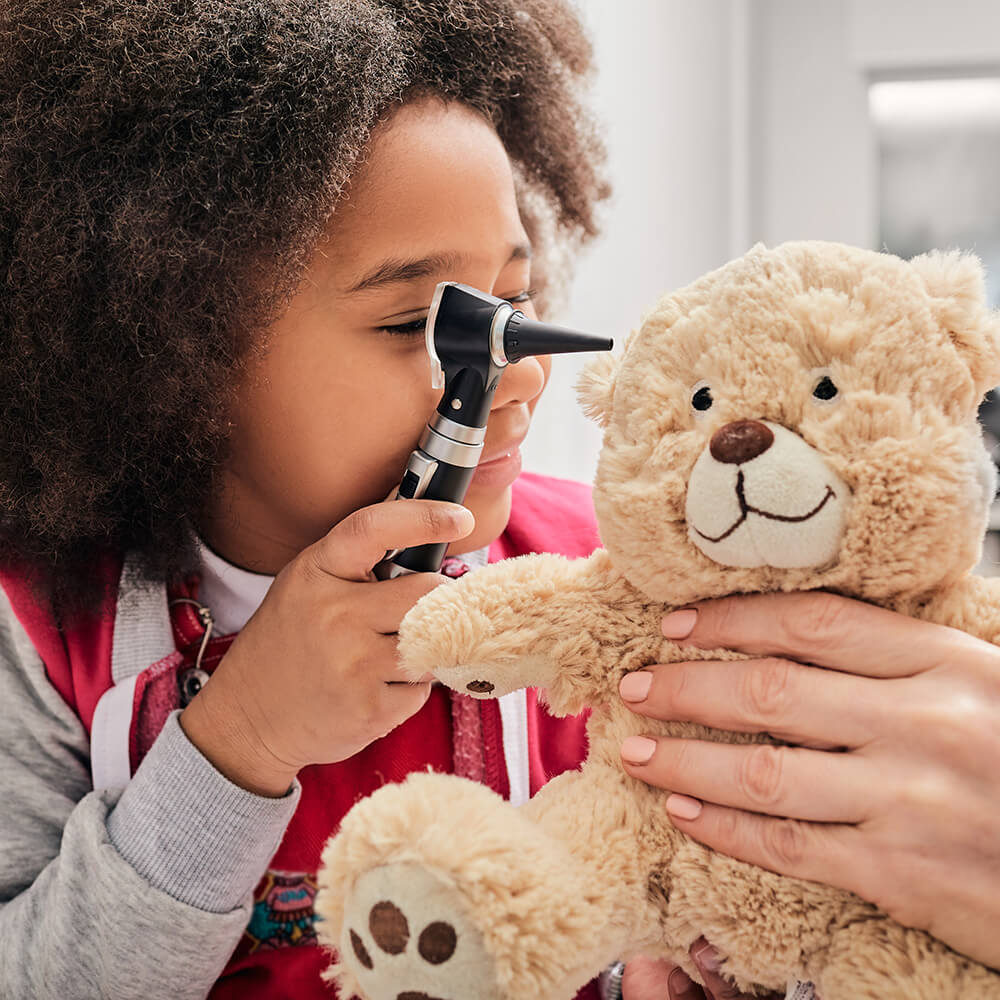Hearing Loss
Types of Hearing Loss
Sensorineural Hearing Loss
In adults, SNHL is most commonly associated with the aging process, a genetic predisposition, exposure to loud noises, head trauma or other conditions as listed below
- Sudden hearing loss - may be caused by a virus and is time-sensitive for treatment
- Aging - gradual hearing loss that cannot be reversed
- Acoustic trauma - exposure to loud noises (e.g. industrial/machinery or explosion, gunfire)
- Head trauma or abrupt changes in air pressure - can cause the space that contains inner ear fluid to rupture
- Autoimmune inner ear disease - the body’s immune system attacks the inner ear and can cause progressive hearing loss in both ears
- Meniere’s disease - a condition characterized by fluctuating hearing loss, dizziness, ear fullness or tinnitus
- Central nervous disease - damage caused by a condition such as multiple sclerosis
- Cochlear otosclerosis - abnormal bone growth in the inner ear
- Congenital inner ear malformation - genetic or environmental abnormalities (common cause in children)
- Benign tumor - acoustic neuroma, this is a noncancerous tumor that can affect hearing and/or balance
Symptoms of SNHL may include
- Muffled hearing
- Difficulty understanding speech
- Sudden or gradual loss of hearing
- Full or “stuffy” sensation in the ear
- Ringing in the ear
Treatment options for SNHL are dependent upon the cause of the loss.
If you are experiencing hearing loss, our doctoral audiologists will determine if a medical referral is necessary. Once a diagnosis is made, appropriate treatment options can be discussed. Often, hearing aids are the best solution.
Sudden sensorineural hearing loss (SSNHL) is a medical emergency defined as an individual experiencing at least 30 dB of sensorineural hearing loss occurring over 3 days or less. It typically occurs when there is damage to the inner ear (cochlea) or to the nerve pathways to the brain.
SSNHL are associated with head trauma (such as a car accident), acoustic trauma (exposure to loud noises), viral infections, tumors, decreased circulation to the inner ear, membrane breaks, exposure to ototoxic medications, or an unknown reason (idiopathic).
Types of Hearing Loss
Conductive Hearing Loss
Causes of Conductive Hearing Loss Include
- Fluid in the middle ear
- Infection in the ear canal
- Wax
- Perforation of the eardrumear drum
- Foreign object in the ear canal
- Allergies
- Malformation of the ossicles in the middle ear
- Otosclerosis
Types of Hearing Loss
Additional Types
Mixed Hearing Loss
Unilateral Hearing Loss
Sudden Sensorineural Hearing Loss
Noise-Induced Hearing Loss
Congenital Hearing Loss

Treating Hearing Loss
Navigating Your Hearing Loss
Don’t Let Hearing Loss Disconnect You from the World
It’s easy to put off a hearing test, but nearly all hearing loss is progressive. It doesn’t get better on its own. The sooner a loss is diagnosed, the more successful treatment will be, and treatment doesn’t just affect your hearing; it can help combat cognitive problems as well.
You’re in control; schedule a hearing test and improve your connection to the world around you.
Have You, Your Partner or a Loved One Experienced These Common Signs of Hearing Loss?
- Family or friends have remarked on your hearing.
- People seem to mumble, or you need them to repeat themselves often.
- You have trouble following conversations in groups, especially with background noise.
- Telephone conversations are difficult to follow.
- Others comment on the volume when you listen to the TV or music.
The ability to communicate clearly is one of the most valuable gifts you can give to another person, but it’s so much more difficult to do when you have trouble hearing.
Imagine understanding words the first time they’re spoken and clearly following every conversation, whether you’re in a crowded restaurant or exercising with a friend. How would better hearing change the way you interact with people and the world?
Medical Conditions of the Ears
Acoustic Neuroma
Cholesteatoma
Ear Infection and Otitis Externa
Middle ear infection (otitis media) often occurs after a cold or with an infection of the upper airway. The Eustachian tube aerates the middle ear to prevent fluid from collecting. The Eustachian tube is a channel from the back of the throat to the ear allowing air to fill the middle ear space. When fluid occurs, it is initially sterile, but with time, it can become infected.
Symptoms of otitis media include: ear pain, fever, decrease in hearing, and possibly drainage from the ear. Treatment may include a course of antibiotics. Long-term fluid may necessitate the need to insert tympanostomy tubes, a small tube placed through the eardrum, that serves a similar function as the Eustachian tube. This is a procedure performed by an ear physician based on the results of a hearing test battery and the medical history.
Otitis Externa (swimmer’s ear) is an infection of the external ear canal. If there is too much wax in the ear canal, water, moisture, and debris may become trapped, increasing the risk for infection. Water from a pond, lake, ocean, and even a hot tub that houses increased bacteria can result in otitis externa. Believe it or not, Q-tips can cause external otitis due to trauma to the skin of the canal! Learn more about Ear Infections.
Eustachian Tube Dysfunction
Eustachian Tube Dysfunction (ETD) occurs when the Eustachian tube, a narrow passageway connecting the middle ear with the nose, is blocked or malfunctions and fails to allow pressure to equalize on both sides of the eardrum.
Most everyone has experienced ETD when they have a cold, allergies or gone up in an airplane. It is the “plugged” sensation you feel. The middle ear is a pressure-filled space that, under normal circumstances, has the same pressure as the environment around you. When the air pressure changes quickly, a normally functioning Eustachian tube will “pop” and re-equalize the pressure around the ear drum. If one has ETD, the Eustachian tube will remain closed in the circumstance and there will be a consistent plugged feeling. Learn more about Eustachian Tube Dysfunction.
Otosclerosis
Otosclerosis is a condition of abnormal bone remodeling in the middle ear. Bone remodeling is a lifelong process in which bone tissue renews itself by replacing old tissue with new. In otosclerosis, abnormal remodeling disrupts the ability of sound to travel from the middle ear to the inner ear.
The ear is a complex system relying on a series of mechanisms to convert incoming sound waves into nerve impulses. Part of this mechanism relies on a tiny bone in the middle ear, called the stapes. In a normal system, the stapes bone is free to move and transmit information along the ossicular chain (comprised of 3 bones in the middle ear). With otosclerosis, it can grow so large or harden so that it no longer moves and eventually causes hearing loss.
Other symptoms of otosclerosis include dizziness or tinnitus. Many cases of otosclerosis are thought to be inherited and white, middle-aged women are most at risk.
Treatment for otosclerosis can include the use of hearing aids or surgery, called a stapedectomy, performed by an ENT or otologist.
Perforation (Hole) in the Tympanic Membrane (Ear Drum)
A perforation is a tear or other opening in the tympanic membrane. Sometimes, this occurs secondary to the presence of fluid behind the eardrum. Ear trauma, such as a blow to the head, or objects puncturing the eardrum (use of a Q-tip), can also cause a perforation and possible hearing loss.
Many perforations heal spontaneously, especially if it is small and located towards the center of the eardrum. Some perforations may require surgical repair, called a tympanoplasty. Learn more about Perforations of the EarDrum.
Semi-circular Canal Dehiscence
Superior Semi-Circular Canal Dehiscence Syndrome (SSCD) is a rare medical condition described as a thinning or complete absence of a portion of the temporal bone overlying the superior semicircular canal of the inner ear, which causes a hypersensitivity to sound and balance disorders.
Symptoms include: vertigo that arises from exposure to loud sounds; dizziness that increases with activity and settles when at rest; hearing loss, tinnitus and fullness can also occur.
Treatment can include surgery to repair the semi-circular canal. Learn more about Semi-circular Canal Dehiscence.

Pediatric Hearing Loss
Adults aren’t the only ones who experience hearing loss
children of all ages can experience a loss of hearing.
What Causes Hearing Loss in Children?
What Are the Symptoms?
- A delay in speech and language
- Failure to respond to loud noises or your voice
- Poor academic performance
- Frequent ear infections
- Disorders associated with hearing loss (e.g. Down syndrome or autism)
- Family history of hearing loss
- Newborn Hearing Loss
Congenital hearing loss refers to hearing loss that is present at birth. Objective hearing testing is available to test babies only hours old. Early identification of hearing loss minimizes the long-term effects of hearing impairment. The two most common tests that are performed on infants are: Otoacoustic Emissions (OAE) and Auditory Brainstem Response (ABR). OAE testing looks at a child’s hearing by placing a small probe microphone into the ear.
Frequency-specific sounds are presented and generate an “echo” back of those sounds. The test measures those echos to determine the integrity of the outer hair cells of the inner ear. The ABR measures the brain’s ability to perceive sound. Small electrodes are placed on a child’s head and ears which measures the brain’s response to sound. Children are given a screening version of one of these tests before being discharged from the hospital.
Treating Hearing Loss in Children
Central Auditory Processing Disorder
Patients with CAPD often feel that they can hear but they can’t understand.
There is a decreased ability to accurately understand speech, particularly when speech is presented at a fast rate and/or in the presence of competing signals (e.g. background noise). This is due to a reduced speed of signal processing within the auditory cortex. This can occur with or without measurable hearing loss and becomes more prevalent with age.
Additionally, there are instances of congenital auditory processing disorders that present in children. It is described as a neurological defect that affects how the brain processes spoken language. It makes it difficult for a child to process verbal instructions due to an inability to “filter out” background noise, such as in a classroom.
Behaviors seen in children with CAPD include
- Mishearing/discrimination problems
- Inability to follow directions
- Problems attending when spoken to
- Distracted by background noise
- Poor organization of verbal material
- Oral and written expression problems
- Remembering what they hear
- Learning to read
How Is CAPD Diagnosed?
Children with CAPD may become withdrawn, isolated and depressed. They often become disruptive and may take unnecessary risks or lash out at others. Because many of the behavioral issues closely mimic those associated with Attention Deficit Hyperactivity Disorder (ADHD) and other learning disabilities, an incorrect diagnosis is often made.
An audiologist can determine the exact nature of your child’s issues through a routine hearing test, which will rule out any physical hearing problems by testing their ability to hear a range of frequencies. If no hearing loss is present, behavioral and electrophysiological testing is administered.
